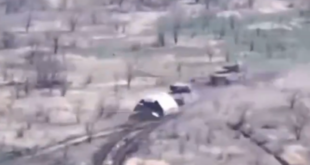Kherson, Ukraine (CNN) — Zip-tying old grenades and mortars to tiny, online-bought drones, and using virtual reality headsets to direct them into Russian targets. It is not the war this four-man drone unit initially signed up for, but it is as effective as it is cheap.
In a rickety old cottage, not far from Kherson city and the Dnipro River, the 11th National Guard Samosud Squad are making up for the United States’ stalling on aid to Ukraine with low-budget ingenuity: Flying small explosive drones into Russian targets on the other side of the Dnipro River.
CNN was granted rare access to one of dozens of Ukraine’s First Person View (FPV) drone teams, along the riverbank outside of Kherson city, to observe the attacks being made by this rudimentary but game-changing technology. Both Ukraine and Russia have harnessed the power of these cost-effective, mobile units, which can deliver payloads from light grenades to thermobaric weapons on enemy infantry, positions or armor, to devastating effect.
The unit CNN visited asked for their names and location to be withheld for their safety. Their operations room is about 15 square meters, with boxes and plastic bags of munitions, multiple piles of drone chassis and propellers, one large TV screen, and two pairs of goggles, more commonly used in gaming.
“We’ve had days so busy, we launched 15 to 20” drones, said one pilot. “I got 10 minutes between flights to rest. I never imagined this would be my war.” The pilot said that only about a third of those trained are able to operate the goggles for an extended period, and some experience dizziness or disorientation after use.
The lethal violence they bring is a disconcerting mixture of the remote and the intimate. First, the team launch along the main highway across the river, where only Russian military vehicles operate, usually at night. “They are aware of the threat we pose,” said the team leader, adding Russian troops had as a result limited their movements in daylight across a swathe of the front.
The drone flies over a wasteland of sand, fallen trees, and weaving trenches. No real target is visible, so the team opt for an established checkpoint on the road, which they say is always manned. The drone veers, circles, and then swings into the green tarpaulin of its target. The screen turns to static and then blue.
The eastern bank has become an unexpected success story for Ukraine. Begun as a series of small landings over the summer, Kyiv has slowly augmented its forces on the occupied side of the Dnipro River. This has pressured Russian units and made small and costly progress toward the Western access route to the Crimean peninsula.
The operation has been criticized as hard to resupply, burdened with Ukrainian casualties, and a drain on scarce resources. But Ukrainian marine advances into Krynky, a small riverside village now only partially controlled by Russian forces, have provided positive news from a mostly static front line. The summer counteroffensive has otherwise failed to provide the breakthrough hoped for from billions of dollars of NATO aid.
Today, Ukraine’s remaining aid funds for this war may total less than a billion dollars. Further aid has been stalled with the US Congress divided over approval of another $61 billion for Ukraine. The FPV unit were acutely aware of the challenges their war would face without continued US financing.
“I think it’ll be very difficult without American help,” said another soldier, as he packed plastic explosive into a rocket-propelled grenade’s warhead, before zip-tying it to a drone. “Our supplies are also running out, so we need them.” Their unit is funded by volunteers.
Five drones cost about the same as a single artillery shell – around $3,000 – according to the team leader, who added that the shells are often inaccurate.
Budget technology
Tips kept coming into the unit from other Ukrainian drone and surveillance teams. An antenna emerging from a tin-roofed building, betraying another drone unit. A red-roofed house where their Russian equivalent drone unit was said to be stationed. The latter took priority, and two drones were launched against it, one leading the way, visible just meters away in its partners’ feed.
“It is at 10 o’clock from the blue-roofed school,” the unit leader said. The first drone swoops down, and then its camera tilts up at the sky.
“Suppressed,” says the pilot, meaning that a Russian jamming device has interrupted its signal. The drone seems to fall to earth with its explosive charge. The screen turns blue.
The second drone picks up the trail. It sees the red-roofed house, set back from the main road. “First floor,” says the team leader. The drone pauses momentarily, and then swings in, the shot freezing, turning to static, and then the screen dropping to blue as the blast cuts the transmission short. “Boom,” said the pilot.
The night shift is operated from another building, some distance away. Red light fills a room brimming with the makeshift, budget technology that has transformed the battlefield in just the past months into the deadly playground of drones.
Here, a unit of three people monitor frequencies to check for the signature bandwidth of a Russian Orlan drone. They have a rare but effective anti-drone rifle, used to jam UAVs when close. But their greatest threat is the same for them as it is for their enemy. Both sides use thermal imaging in the frosty dead of winter nights to spot infantry or vehicles.
Their cameras pick up specks of heat in a forest just outside of Krynky. “Russian positions,” says one pilot, known by the call sign “Journalist.”
The freezing fog means some drones cannot fly at higher altitude and restricts their work. The winter weather is a constant plague. But it has also supplied the unit with an experimental means of avoiding detection by Russian thermal cameras: A poncho, with a face visor stitched to it, is kept in the cold outside. Its lining retained the freezing temperature of the outside air, and when worn exposed only the heat of the soldier’s arms and legs.
This, the unit said, rendered the wearer invisible to the thermal imaging Russian drones above. “I never thought I would feel like Neil Armstrong in this war,” the operator said.
The night provides no respite for the civilians of Kherson. On Sunday night, a series of Shahed-type Russian drones flew over the city, the loud and heavy Russian attack drone which also detonates itself when its hits its target. The drones flew directly over CNN’s position, their engines growling deeper and louder as they approached. A blackout enforced across the city, the only light came from passing cars and the occasional flash of anti-aircraft guns, shaking the night sky.
The city itself was relentlessly struck. Around noon on Monday, incoming artillery shells came every few minutes, and the whistle of rounds passing overhead was common in the city center. Regardless of the persistent threat, thousands of Kherson residents remained on the streets, appearing oblivious to a pace of explosions more suited to a town fought over by two opposing sides.
Warped normality
While Kherson was liberated in November last year, it remains firmly in the grip of Russia’s war. Ukraine’s small advances on the eastern bank of the Dnipro River have visited the wrath of Russian artillery on the population centres, and in some streets every residential building appears damaged. Kherson has become a vivid example of why Ukraine insists it cannot live near Russian occupied territory, as Moscow’s guns will not fall silent, and are forcing a warped normality onto daily life.
On Sunday morning, a hurried line of mostly older locals appeared on one street, headed single file in the same direction. Word had got out the church would briefly distribute aid from a nearby hall. Several dozen people packed its doorway for about 15 minutes, until the bags of pasta and oats were exhausted. Two pensioners appeared to scrap over one food package. Natalia, 75, insisted life was “fine.”
“It’s loud, there is constant bombing, but we live on,” she said.
Several children’s playgrounds are ominously surrounded by newly-erected blast barriers. The city’s maternity hospital, struck multiple times by artillery, has decided to move its ward to the basement, into stronghold rooms originally built in the 1970s as shelters for nuclear war. Three patients can be accommodated here, staff said, whereas before the war they would anticipate twenty.
Yet still, during the small hours of Monday as intense shelling rocked locals awake, Yevhenia gave birth at 4 a.m. to tiny Kira. The mother is adamant they will only leave Kherson if the heating fails this winter. Their family and friends are mostly here.
“Why would I leave? It’s my home,” she said. “We’ve gotten used to the shelling.”
Her daughter Kira was conceived in spring, when an end to the war was imaginable, yet born into a city caught in Russia’s slow grind to nothing.
The-CNN-Wire
™ & © 2023 Cable News Network, Inc., a Warner Bros. Discovery Company. All rights reserved.
 Unmanned Aerial Vehicle The latest drone news
Unmanned Aerial Vehicle The latest drone news



